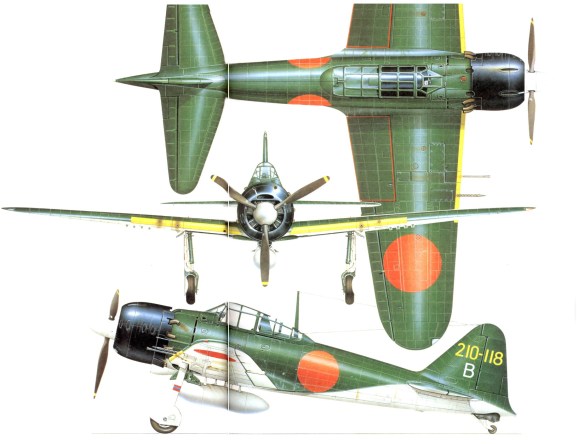A6M5c Type 0 Model 52
Considered the most effective variant, the Model 52 was developed to face the powerful American Hellcat and Corsair, superior mostly for engine power and armament. The variant was a modest update of the A6M3 Model 22, with non-folding wing tips and thicker wing skinning to permit faster diving speeds, plus an improved exhaust system. The latter used four ejector exhaust stacks, providing an increment of thrust, projecting along each side of the forward fuselage. The new exhaust system required modified “notched” cowl flaps and small rectangular plates which were riveted to the fuselage, just aft of the exhausts. Two smaller exhaust stacks exited via small cowling flaps immediately forward of and just below each of the wing leading edges. The improved roll-rate of the clipped-wing A6M3 was now built in.
Sub-variants included:
* “A6M5a Model 52a «Kou»,” featuring Type 99-II cannon with belt feed of the Mk 4 instead of drum feed Mk 3 (100 rpg), permitting a bigger ammunition supply (125 rpg)
* “A6M5b Model 52b «Otsu»,” with an armor glass windscreen, a fuel tank fire extinguisher and the 7.7 mm (.303 in) Type 97 gun (750 m/s muzzle velocity and 600 m/1,970 ft range) in the left forward fuselage was replaced by a 13.2 mm/.51 in Type 3 Browning-derived gun (790 m/s muzzle velocity and 900 m/2,950 ft range) with 240 rounds. The larger weapon required an enlarged cowling opening, creating a distinctive asymmetric appearance to the top of the cowling.
* “A6M5c Model 52c «Hei»” with more armor plate on the cabin’s windshield (5.5 cm/2.2 in) and behind the pilot’s seat. The wing skinning was further thickened in localised areas to allow for a further increase in dive speed. This version also had a modified armament fit of three 13.2 mm (.51 in) guns (one in the forward fuselage, and one in each wing with a rate of fire of 800 rpm), twin 20 mm Type 99-II guns and an additional fuel tank with a capacity of 367 L (97 US gal), often replaced by a 250 kg bomb.
The A6M5 had a maximum speed of 540 km/h (340 mph) and reached a height of 8,000 m (26,250 ft) in nine minutes, 57 seconds. Other variants were the night fighter A6M5d-S (modified for night combat, armed with one 20 mm Type 99 cannon, inclined back to the pilot’s cockpit) and A6M5-K “Zero-Reisen”(model l22) tandem trainer version, also manufactured by Mitsubishi.
The legendary A6M (the dreaded Zero) was the first carrier-based fighter in history to outperform land-based equivalents, and it arrived in greater quantities than any other Japanese aircraft. Despite the Zero’s aura of invincibility, better Allied machines gradually rendered it obsolete.
#
As early as 1937 the Imperial Japanese Navy began searching for a craft to replace its A5M carrier-based fighters. That year it issued specifications so stringent that only Mitsubishi was willing to hazard a design. Specifically, the navy wanted a fighter of prodigious range and maneuverability, one able to defeat bigger land-based opponents. A design team headed by Jiro Horikoshi originated a prototype in 1939. The A6M was a study in aerodynamic cleanliness despite its bulky radial engine. It had widetrack undercarriage for easy landing and was heavily armed with two cannons and two machine guns. Tests proved it possessed phenomenal climbing and turning ability, so it entered production in 1940, the Japanese year 5700. Henceforth, the new fighter was known officially as the Type 0, but it passed into history as the Reisen, or Zero.
A small production batch of 30 Zeroes was sent to China in the summer of 1940 for evaluation, and they literally swept the sky of Chinese opposition. Such prowess was duly noted by Claire L. Chennault, future commander of the famed Flying Tigers, but his warnings were ignored. Zeroes subsequently spearheaded the Japanese attack on Pearl Harbor in December 1941, and over the next six months they ran roughshod over all Allied opposition. However, following the Japanese defeat at Midway in June 1942, the fabled fighter lost much of its ascendancy to new Allied fighters and a growing shortage of experienced pilots. New and more powerful versions of the Zero were introduced to stem the tide, but relatively weak construction could not withstand mounting Allied firepower. Furthermore, the additional weight of new weapons and equipment eroded its famous powers of maneuver. By 1945 most A6Ms had been converted into kamikazes in a futile attempt to halt the Allied surge toward the homeland. A total of 10,964 were constructed.
